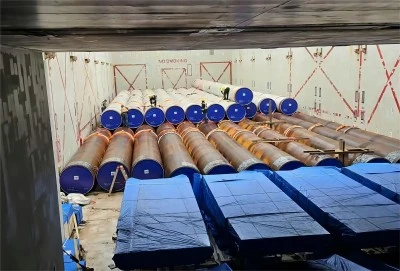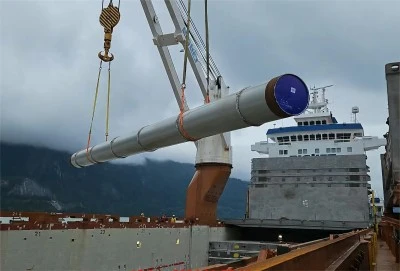ASTM A252 is a crucial standard specification for welded and seamless steel pipe piles used in various construction and engineering applications. This specification, developed by the American Society for Testing and Materials (ASTM), outlines the requirements for steel pipe piles manufactured through welding or seamless processes. ASTM A252 steel pipes are widely utilized in deep foundation projects, marine structures, and offshore platforms due to their exceptional strength, durability, and corrosion resistance. The standard covers essential aspects such as chemical composition, mechanical properties, and manufacturing processes, ensuring the reliability and performance of these steel pipe piles in demanding environments.
|
|
|
ASTM A252: Grades and Chemical Composition
A252 Grade 1, 2, and 3: Strength and ApplicationsASTM A252 steel pipes are available in three distinct grades, each tailored to specific strength requirements and applications. Grade 1 offers the lowest strength but maintains excellent ductility, making it suitable for less demanding projects. Grade 2 strikes a balance between strength and ductility, finding widespread use in various construction applications. Grade 3 boasts the highest strength among the three, making it ideal for heavy-duty structural support and marine environments.
Grade 1 pipes are often employed in temporary structures or where lower load-bearing capacity is sufficient. Grade 2 pipes are commonly used in bridge construction, building foundations, and general piling applications. Grade 3 pipes excel in offshore platforms, harbor structures, and high-load bearing foundations where maximum strength is paramount.
Chemical Composition: Carbon, Manganese, and More
The chemical composition of ASTM A252 steel pipes plays a crucial role in determining their properties and performance. The standard specifies limits for various elements, including carbon, manganese, phosphorus, and sulfur. Carbon content is carefully controlled to achieve the desired balance between strength and weldability. Manganese enhances the steel's strength and hardenability, while phosphorus and sulfur are kept to minimum levels to prevent embrittlement and improve overall quality.
For instance, Grade 1 pipes typically have a lower carbon content compared to Grade 3, allowing for easier welding and fabrication. The precise chemical composition may vary slightly depending on the manufacturing process and specific requirements of the end-use application.
Impact of Alloying Elements on A252 Pipe Properties
Alloying elements in ASTM A252 steel pipes significantly influence their mechanical and physical properties. Chromium and nickel may be added to improve corrosion resistance, particularly in marine environments. Silicon contributes to deoxidation and strength enhancement. Molybdenum increases hardenability and improves high-temperature strength, which is beneficial for pipes used in demanding industrial applications.
The careful balance of these alloying elements ensures that ASTM A252 steel pipes meet the required strength, toughness, and durability specifications while maintaining good weldability and formability. This balance is crucial for the pipes to perform effectively in various environmental conditions and under different load scenarios.
Manufacturing Process: Welded vs. Seamless A252 Pipes
ERW and LSAW Techniques for Welded A252 PipesWelded ASTM A252 steel pipes are manufactured using two primary techniques: Electric Resistance Welding (ERW) and Longitudinal Submerged Arc Welding (LSAW). ERW involves passing an electric current through the edges of a rolled steel plate, creating heat that fuses the edges together. This method is efficient for producing smaller diameter pipes with excellent dimensional accuracy.
LSAW, on the other hand, is used for larger diameter pipes and involves welding a longitudinal seam along the length of a formed steel plate. This technique allows for the production of pipes with thicker walls and larger diameters, making them suitable for high-pressure applications and offshore structures.
Seamless A252 Pipe Production: From Billet to Pipe
Seamless ASTM A252 steel pipes are produced through a different process that starts with a solid steel billet. The billet is heated to high temperatures and then pierced or extruded to create a hollow shell. This shell is then rolled and stretched to achieve the desired diameter and wall thickness. The seamless production method eliminates the need for welding, resulting in a pipe with uniform properties throughout its cross-section.
The seamless production process requires specialized equipment and expertise but offers advantages in terms of pressure resistance and overall structural integrity. These pipes are often preferred for applications involving high internal pressures or where the absence of a weld seam is critical.
Comparing Welded and Seamless A252 Pipe Performance
Both welded and seamless ASTM A252 steel pipes have their unique strengths and are chosen based on specific project requirements. Welded pipes often offer cost advantages and are suitable for a wide range of applications, particularly where high pressure resistance is not the primary concern. They can be produced in larger diameters and longer lengths, making them ideal for extensive pipeline projects.
Seamless pipes, while generally more expensive, provide superior pressure resistance and uniform mechanical properties. They are often preferred in critical applications such as high-pressure systems, offshore drilling, and certain structural supports where the absence of a weld seam is beneficial.
The choice between welded and seamless A252 pipes depends on factors such as project specifications, environmental conditions, load requirements, and budget considerations. Both types, when manufactured to ASTM A252 standards, offer reliable performance and durability for their intended applications.
Quality Control Measures in A252 Pipe Production
Non-Destructive Testing Methods for A252 PipesQuality control is paramount in the production of ASTM A252 steel pipes to ensure they meet the rigorous standards required for their intended applications. Non-destructive testing (NDT) methods play a crucial role in this process, allowing manufacturers to inspect pipes without compromising their integrity. Ultrasonic testing is widely used to detect internal flaws, laminations, and wall thickness variations. This method uses high-frequency sound waves to penetrate the pipe material, revealing any inconsistencies or defects.
Magnetic particle inspection is another common NDT technique, particularly effective for detecting surface and near-surface flaws in ferromagnetic materials. For welded pipes, radiographic testing is often employed to examine the quality of the weld seam, ensuring proper fusion and the absence of defects such as porosity or inclusions.
Mechanical Properties Testing: Tensile and Impact
Mechanical properties testing is essential to verify that ASTM A252 steel pipes meet the specified strength and toughness requirements. Tensile testing involves subjecting pipe samples to controlled tension until failure, measuring properties such as yield strength, tensile strength, and elongation. These tests ensure that the pipes can withstand the expected loads in their intended applications.
Impact testing, often performed using the Charpy V-notch test, assesses the pipe material's toughness and ability to resist brittle fracture. This is particularly important for pipes used in low-temperature environments or subject to dynamic loading. The results of these tests help engineers and project managers make informed decisions about the suitability of the pipes for specific projects.
Dimensional Tolerances and Surface Finish Requirements
ASTM A252 specifies strict dimensional tolerances for steel pipe piles to ensure proper fit and performance in various applications. These tolerances cover aspects such as outside diameter, wall thickness, length, and straightness. Accurate dimensional control is crucial for ease of installation and structural integrity, particularly in foundation and marine applications where precise fit is essential.
Surface finish requirements are also addressed in the ASTM A252 standard. The pipes must be free from defects that could impair their strength or suitability for the intended use. This includes specifications for surface roughness, absence of laminations, and proper coating application where required. Regular inspections and measurements during the manufacturing process help ensure compliance with these dimensional and surface finish requirements.
ASTM A252 standard specification for welded and seamless steel pipe piles is a cornerstone in the construction and engineering industries. It provides a comprehensive framework for the production, testing, and quality control of steel pipes used in critical applications. By adhering to this standard, manufacturers ensure the reliability, durability, and performance of their products. For engineers and project managers, understanding the nuances of ASTM A252 steel pipes - from grades and chemical composition to manufacturing processes and quality control measures - is essential for making informed decisions in infrastructure and construction projects.
Buy ASTM A252 Steel Pipe
When it comes to sourcing high-quality A252 steel pipe, Hebei Longma Group stands out as a reliable and professional supplier. With advanced production equipment imported from Germany and independently developed technologies, Longma Group ensures top-notch quality in every pipe produced. Our team of over 300 employees, including more than 60 technical personnel, brings extensive expertise to the manufacturing process.
Longma Group's comprehensive testing facilities, including online ultrasonic automatic flaw detectors and industrial X-ray television, guarantee that every ASTM A252 steel pipe meets the highest quality standards. We pride ourselves on fast delivery, with the ability to complete production of standard thickness steel pipes in as little as 7 days. Our complete certification, including API 5L, ISO 9001, ISO 14001, and FPC certificates, demonstrates our commitment to quality and environmental responsibility.
Thanks to our long-term partnerships with raw material suppliers and our integrated production model, we offer competitive prices without compromising on quality. For more information about our A252 steel pipes or to discuss your project requirements, contact us at info@longma-group.com. Our team is ready to provide expert guidance and support for your steel pipe needs.














